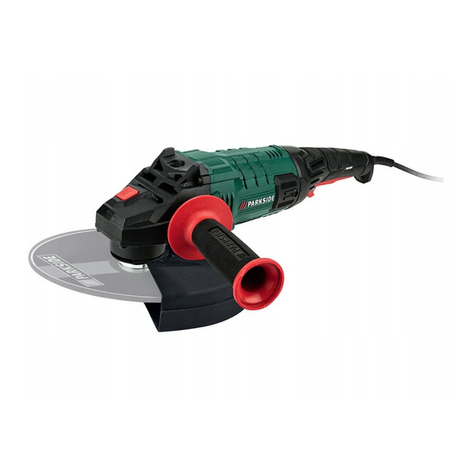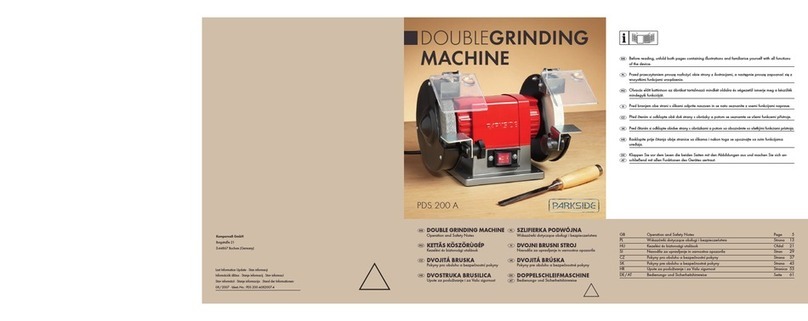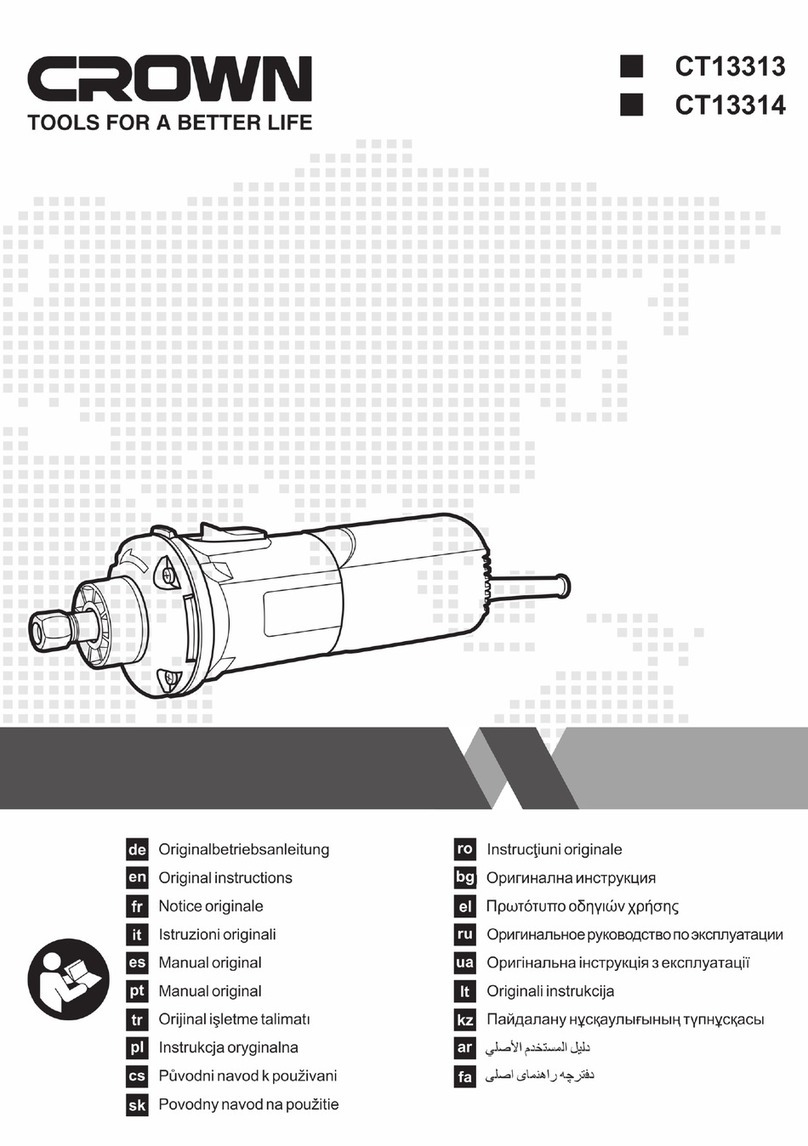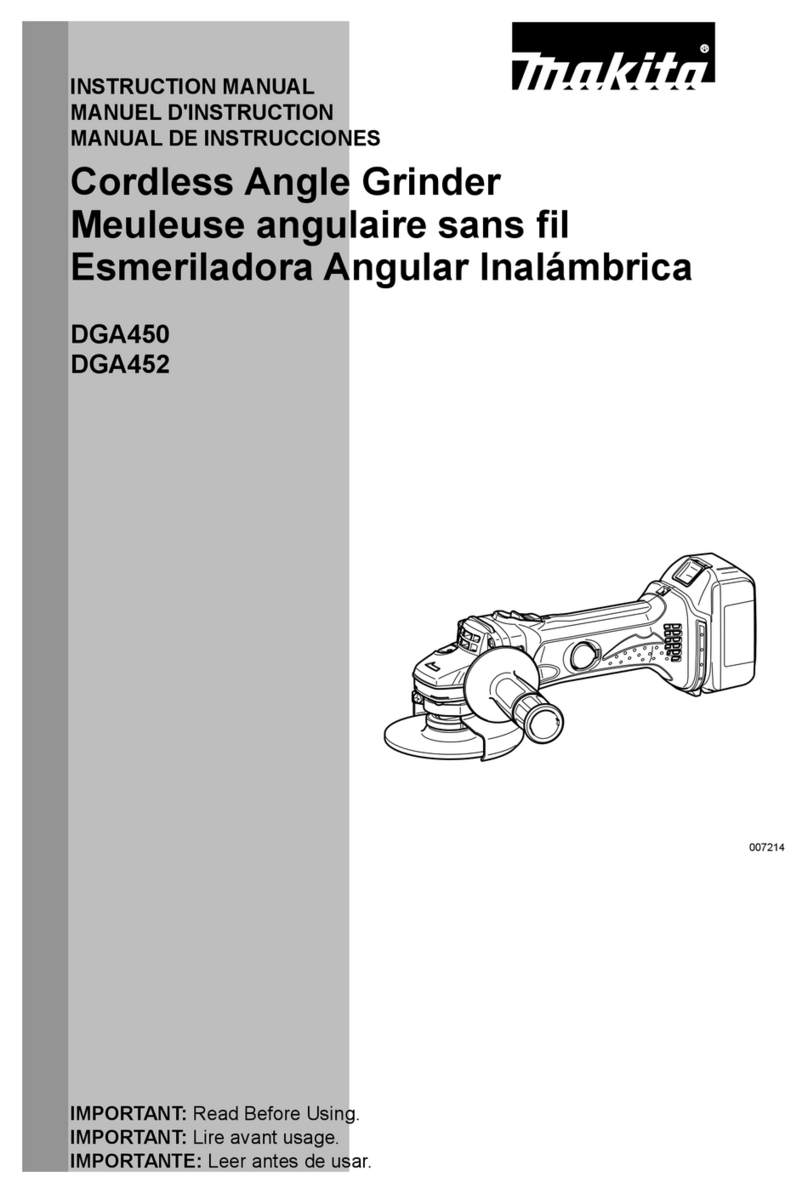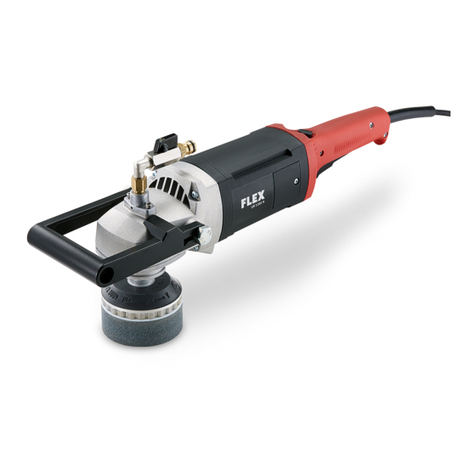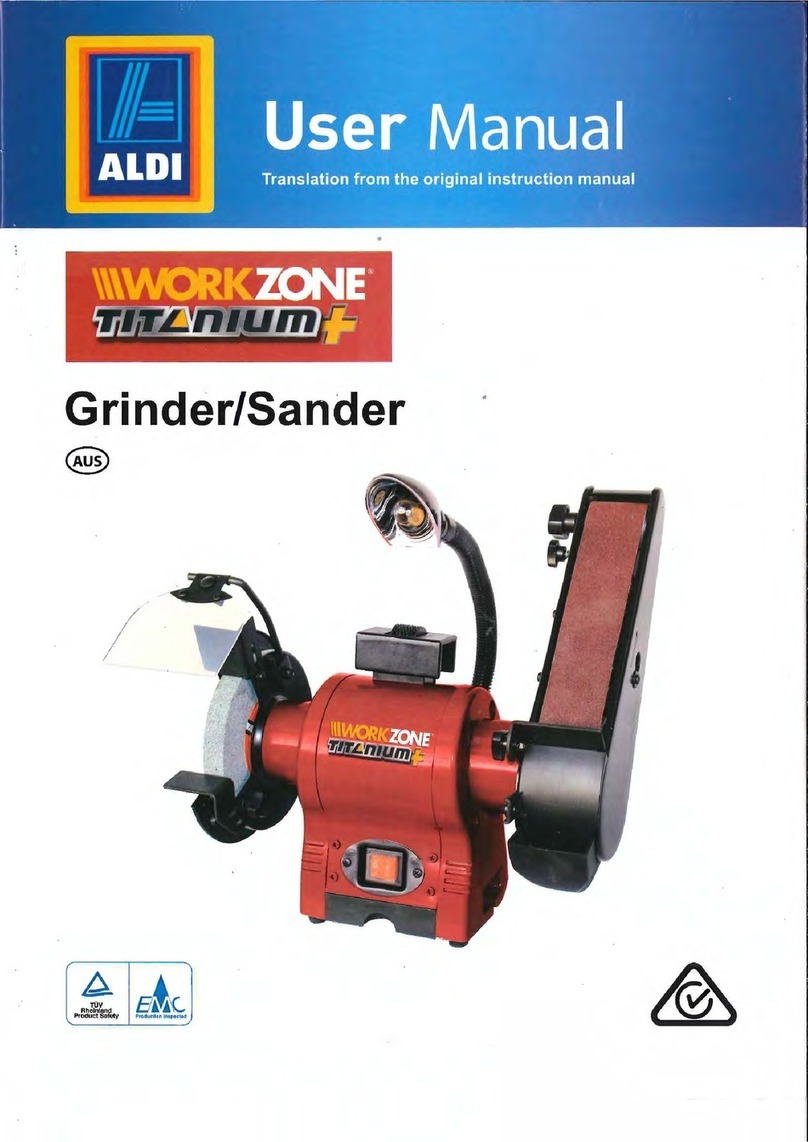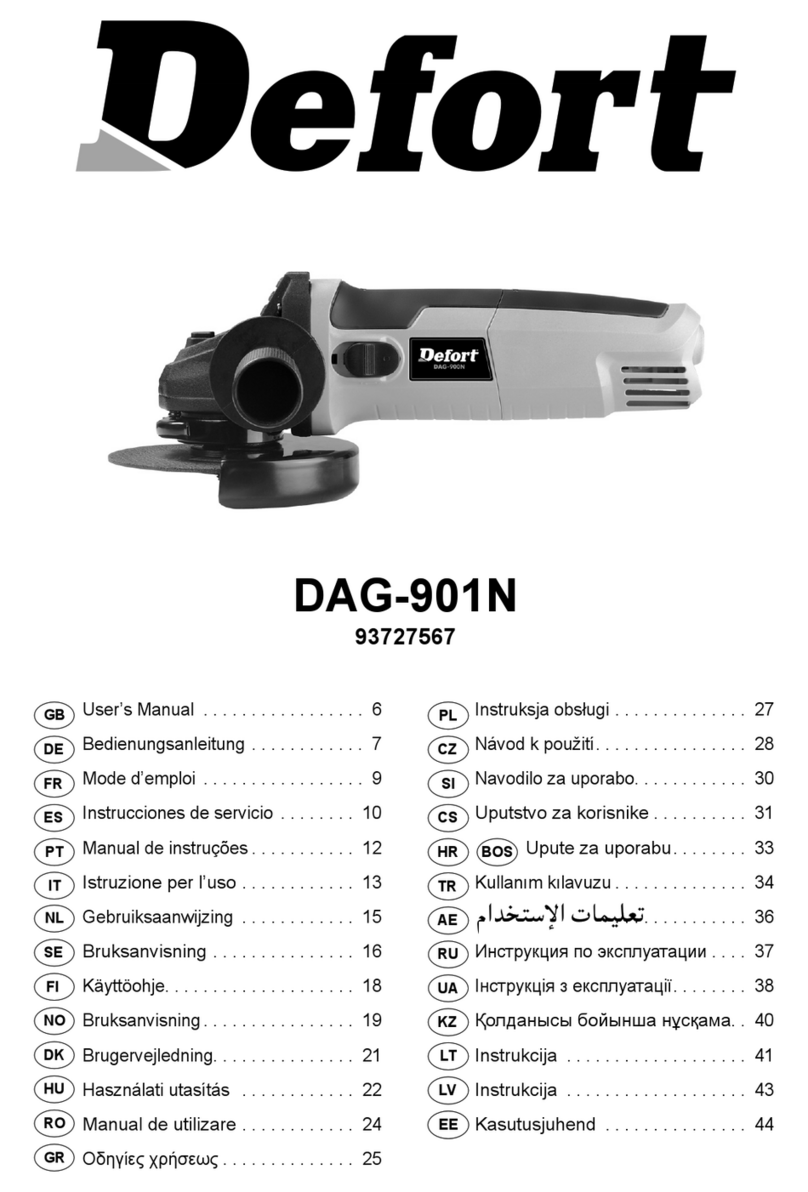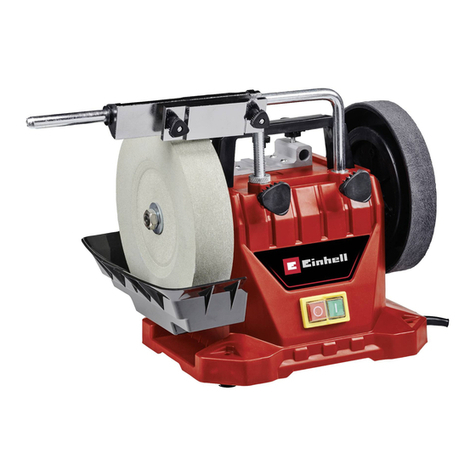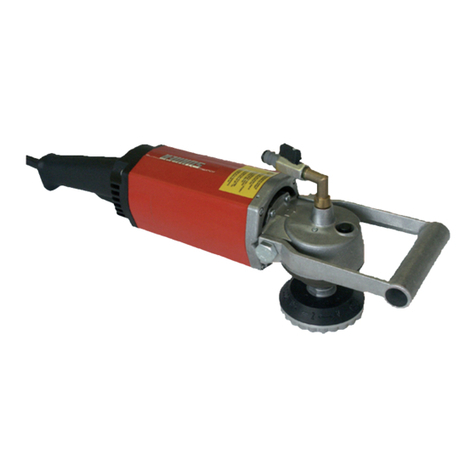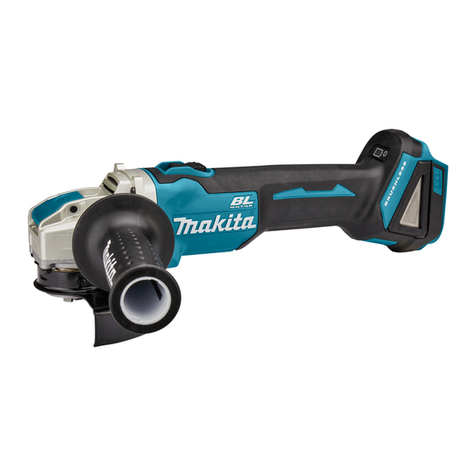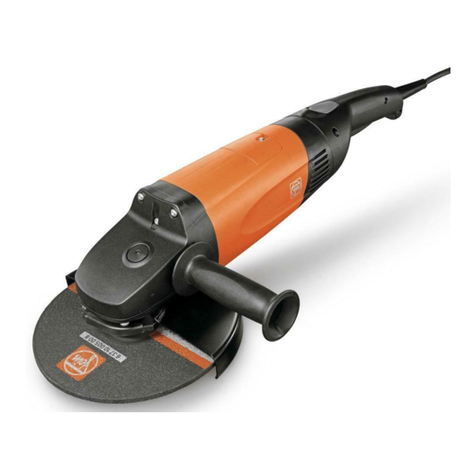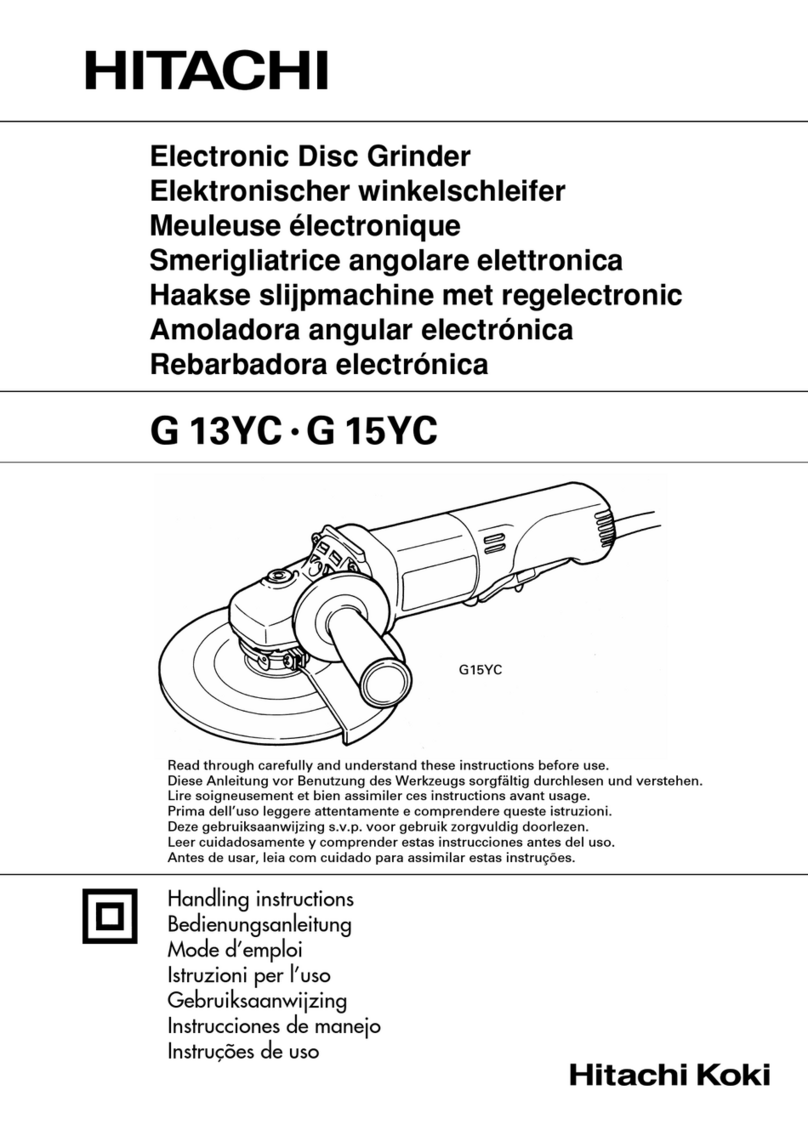Hausmann PNT118-C User manual

Modèle / Model:
PNT118-C
PNT118-C
68125025
Operator’s Manual (p.12)
Manuel de l'utilisateur (p.2)
MINI RECTIFIEUSE PNEUMATIQUEMINI RECTIFIEUSE PNEUMATIQUE
AIR-POWERED MINI DIE GRINDER
CONSERVEZ CE GUIDE
Vous aurez besoin de ce guide pour les règles de sécurité, les procédures d'utilisation et la garantie.
Conservez-le avec votre facture d'origine dans un endroit sûr et au sec pour référence future.
SAVE THIS MANUAL
You will need this manual for safety instructions, operating procedures, and warranty.
Put it and the original sales invoice in a safe, dry place for future reference.
QUESTIONS? 1-866-206-0888
Notre personnel du service à la clientèle est disponible pour vous aider.
Pour obtenir de l'aide pour le montage de votre produit, pour signaler
des pièces endommagées ou manquantes, ou pour toute autre
information, veuillez composer notre numéro sans frais: 1-866-206-0888.
Enregistrez votre produit
Nous vous invitons à enregistrer votre produit en ligne afin de faciliter les
communications; pour ce faire, veuillez visiter le
www.outilshaussmann.com
Our Customer service staff is available to help you.
For help with product assembly, to report damaged or missing parts, or
for any other information, please call our toll-free number:
1-866-206-0888.
Register your product
We invite you to register your product online to make future
communications easier. To do so, simply visit our website
www.haussmanntools.com.

RÈGLES DE SÉCURITÉ IMPORTANTES
FRANÇAIS
TABLE DES MATIÈRES
p.3
p.5
p.6
p.6
p.6
p.8
p.9
p.10
LISTE DES PIÈCES
p.8
CARACTÉRISTIQUES TECHNIQUES
ENTRETIEN ET ENTREPOSAGE
DÉPANNAGE
GARANTIE
2PNT118-C
NOMENCLATURE DES PIÈCES
RÈGLES DE SÉCURITÉ SUPPLÉMENTAIRES POUR
RECTIFIEUSE PNEUMATIQUE
RÉGLAGE ET FONCTIONNEMENT
p.11
SCHÉMA
p.2
SYMBOLES
SYMBOLES
Certains des symboles suivants peuvent être utilisés sur cet outil. Veuillez
les étudier et apprendre leur signification. Une interprétation correcte de ces
symboles permettra d'utiliser l'outil plus facilement, et de façon plus sécuritaire.
Lisez le manuel d'utilisation: Pour réduire les risques de blessures, l'utilisateur doit
lire et comprendre le manuel d'utilisation avant d'utiliser ce produit.
Protection des yeux: Toujours porter des lunettes de sécurité, des lunettes de
sécurité avec écrans latéraux ou un écran facial lors de l'utilisation du produit.
Risque de dommages auditifs: Portez toujours une protection auditive lors de
l'utilisation de cet outil, afin de prévenir les pertes auditives et autres
dommages à l'ouïe.
!
!
!
AVERTISSEMENT! Les mises en garde et les précautions dont il est question dans
le présent manuel ne couvrent pas toutes les conditions et les situations possibles.
L'utilisateur doit comprendre qu'il est impératif de faire preuve de jugement et de prudence.
AVERTISSEMENT! Pour éviter tout risque de blessure grave, ne tentez pas
d'utiliser cet outil avant d'avoir lu entièrement le manuel et de l'avoir compris.
Conservez ce manuel et consultez-Ie fréquemment pour une utilisation sécuritaire
par toute personne qui utilise cet outil.
CONSERVEZ CE MANUEL: Gardez ce manuel qui contient les avertissements de
sécurité, les précautions à prendre, le mode de fonctionnement, les inspections et
l'entretien à effectuer. Gardez ce manuel et le reçu dans un endroit sec et sécuritaire
pour référence ultérieure.

3
FRANÇAIS
RÈGLES DE SÉCURITÉ IMPORTANTES
!
INSTRUCTIONS RELATIVES AU RISQUE D'INCENDIE, OU AU RISQUE DE
BLESSURES.
AVERTISSEMENT! Lors de l'utllisation des outils, il est toujours essentiel de suivre
les mesures de sécurité de base, y compris celles qui suivent.
ZONE DE TRAVAIL
Gardez toujours votre lieu de travail propre et bien éclairé. Les établis encombrés
et les endroits sombres peuvent donner lieu à des accidents.
Ne faites pas fonctionner les outils électriques dans des atmosphères explosives,
comme en présence de liquides inflammables, de gaz ou de poussière. Les outils
électriques produisent des étincelles qui peuvent enflammer les poussières ou les
vapeurs.
Les spectateurs, les enfants et les visiteurs doivent se tenir à distance lorsque
vous manipulez un outil électrique. Toute distraction peut vous faire perdre le
contrôle de l'appareil. Protégez les personnes présentes sur le lieu de travail des
débris, comme les copeaux et les étincelles. Placez des barrières ou des écrans
de protection lorsque c'est nécessaire.
SÉCURITÉ PERSONNELLE
Demeurez vigilant, faites attention à ce que vous faites et faites preuve de
jugement lorsque vous utilisez un outil électrique. N'utilisez pas l'outil si vous êtes
fatigué ou lorsque vous avez pris de Ia drogue, de l'alcool ou des médicaments.
De graves blessures peuvent résulter d'un moment d'inattention lors de
l'utilisation de l'outil.
Portez des vêtements appropriés. Évitez de porter des vêtements amples ou des
bijoux. Attachez les cheveux longs. Gardez les cheveux, Ies vêtements et Ies
gants à l'écart des pièces mobiles. Les vêtements amples, bijoux ou cheveux
longs pourraient se prendre dans les pièces mobiles.
Enlevez les clés de réglage avant de démarrer l'outil. Un outil ou une clé laissée
sur une pièce rotative de l'outil augmente le risque de blessures personnelles.
N'attachez pas Ie tuyau ou l'outil à votre corps. Attachez le tuyau à la structure
pour réduire le risque de perte d'équilibre si le tuyau se déplace.
Portez un équipement de protection. ll faut utiliser un masque antipoussières, des
chaussures de sécurité à semelle antidérapante et un casque, en fonction des
conditions de travail.
Portez toujours des lunettes de sécurité.
Portez toujours des protecteurs auditifs Iorsque vous utilisez l'outil. Une
exposition prolongée à des bruits de grande intensité risque de causer une perte
auditive.
Déconnectez l'outil de la source d'air avant de le régler.
Évitez les démarrages accidentels. Assurez-vous que l'interrupteur est hors
tension avant de brancher l'alimentation d'air. Ne pas transporter l'outil avec le
doigt sur l'interrupteur ou connecter l'outil à la source d'air avec l'interrupteur en
marche.
Les accessoires doivent être conçus pour fonctionner à une pression conforme à
celle indiquée sur la plaque signalétique de l'outil. Des accessoires ne
correspondant pas à la vitesse nominale peuvent se détacher et causer un risque
de blessures.
UTILISATION ET ENTRETIEN DE L'OUTIL
Utilisez un étau ou un autre moyen pratique pour fixer et soutenir la pièce de
travail sur une plate-forme stable. Tenir la pièce de travail d'une main ou contre
votre corps est dangereux et peut provoquer une perte de contrôle.

FRANÇAIS
4PNT118-C
RÈGLES DE SÉCURITÉ IMPORTANTES
Ne forcez pas l'outil. Utilisez l'outil adapté à votre application. L'outil approprié, et
utilisé selon les instructions, vous permettra de faire un travail plus efficacement
et avec plus de sûreté.
Ne forcez pas l'outil. Utilisez l'outil adapté à votre application. L'outil approprié, et
utilisé selon les instructions, vous permettra de faire un travail plus efficacement
et avec plus de sûreté.
N'utilisez pas l'outil si le bouton marche/arrêt ne fonctionne pas. Tout outil qui ne
peut pas être contrôlé avec le bouton marche/arrêt est dangereux et doit être
réparé.
Débranchez l'outil de la source d'air avant de procéder au réglage, au
remplacement d'accessoires ou au rangement de l'outil. Ces mesures de sécurité
préventives réduisent les risques de démarrage accidentel de l'outil.
Rangez l'outil non utilisé hors de portée des enfants ou des personnes non
familières avec l'outil. Les outils sont dangereux dans les mains d'utilisateurs
inexpérimentés.
Entretenez les outils avec soin. Les lames doivent rester tranchantes et propres.
Les outils bien entretenus, avec des bords tranchants, sont moins susceptibles de
bloquer et sont plus faciles à contrôler. N'utilisez pas un outil s'il est endommagé.
Marquez l'outil endommagé « Ne pas utiliser » jusqu'à sa réparation.
Vérifiez que les pièces mobiles ne sont ni mal alignées ni bloquées, ni affectées
par toute autre condition pouvant entraver leur bon fonctionnement. En cas de
dommage, faites réparer l'outil avant utilisation. De nombreux accidents ont pour
cause des outils mal entretenus.
Utilisez uniquement les accessoires recommandés par le fabricant de votre
modèle. Les accessoires adaptés à un outil peuvent devenir dangereux s'ils sont
utilisés sur un autre outil.
ENTRETIEN
L'outil ne doit être réparé que par un réparateur qualifié.
Pour réparer l'outil, n'utilisez que des pièces de rechange identiques aux pièces
originales. Utilisez uniquement les pièces autorisées.
Utilisez uniquement le lubrifiant pour outils pneumatiques fourni et/ou recommandé
par le fabricant.
ALIMENTATION EN AIR ET CONNEXIONS
Le connecteur de l'outil ne doit pas retenir la pression lorsque l'alimentation en air
est déconnectée. Si un mauvais raccord est utilisé, l'outil pourrait avoir encore de
la pression après avoir été débranché et être opérationnel même après le
débranchement du boyau d'air, pouvant ainsi entraîner des blessures.
N'utilisez aucun type de gaz réactif, notamment l'oxygène et les gaz combustibles
comme source d'énergie. N'utilisez que de l'air comprimé filtré, lubrifié et contrôlé.
L'utilisation d'un gaz réactif plutôt que d'air comprimé pourrait causer l'explosion
de l'outil qui pourrait entraîner la mort ou des blessures graves.
N'utilisez qu'une source d'alimentation en air comprimé dont la pression est
contrôlée afin de limiter la pression d'air de l'outil. La pression contrôlée ne doit
pas excéder 100 lb/po2. Dans l'éventualité d'une défaillance du régulateur, la
pression de l'outil ne doit pas excéder 200 lb/po2. L'outil pourrait exploser, ce qui
pourrait entraîner la mort ou des blessures graves.
Déconnectez toujours la source d'alimentation en air:
a) avant de faire des réglages.
b) pendant l'entretien de l'outil.
c) lorsque vous libérez un coincement.
d) lorsque l'outil n'est pas utilisé.
e) lors d'un déplacement vers une autre zone de travail, afin d'éviter une
activation accidentelle pouvant causer des blessures.

FRANÇAIS
5
!
!
RÈGLES DE SÉCURITÉ SUPPLÉMENTAIRES POUR RECTIFIEUSE PNEUMATIQUE
Inspectez toujours la rectifieuse pneumatique avant chaque utilisation pour:
a) vous assurer que la source d'alimentation utilisée convient;
b) vérifier si l'outil est en bon état de fonctionnement.
N'utilisez pas un outil qui n'est pas en bon état de fonctionnement.
N'utilisez pas d'oxygène ni d'autre gaz combustible ou en bouteille pour alimenter
cet outil.
N'utilisez pas l'outil en présence de liquides ou de gaz inflammables.
Utilisez uniquement des accessoires conçus spécialement pour les rectifieuses
pneumatiques.
Videz le réservoir d'air tous les jours. De l'eau dans le conduit d'air pourrait
endommager la rectifieuse.
Nettoyez le filtre à air chaque semaine.
Il faut augmenter la pression dans le tuyau si le tuyau d'air est inhabituellement
long (plus de 26 pi/8 m) pour rétablir l'équilibre. Le tuyau doit avoir 3/8 po (10 mm)
de diamètre intérieur.
Tenez le tuyau loin de la chaleur, de l'huile et des arêtes tranchantes. Vérifiez que
le tuyau d'air n'est pas usé et que tous les connexions sont bien solides.
AVERTISSEMENT! En raison des étincelles générées au moment du ponçage de
nombreux matériaux, assurez-vous que la surface de travail est libre de tout matériau,
liquide ou gaz inflammables.
Assurez-vous toujours que l'outil est éteint avant de le brancher à la source d'air
comprimé.
Débranchez l'outil de la source d'air comprimé avant de changer un accessoire de
ponçage, ou d'effectuer un entretien de l'outil.
AVERTISSEMENT: assurez-vous que les accessoires de ponçage utilisés avec cet
outil ont une vitesse prescrite identique ou supérieure à celle de l'outil (25 000 tr/min).
Le non-respect de cette règle peut entraîner des blessures graves.
Gardez toujours l'outil pneumatique propre et lubrifié. Une lubrification quotidienne
est essentielle afin d'éviter la corrosion interne et un bris de l'outil.
N'utilisez que des tuyaux flexibles pour relier l'outil au raccord mural ou au
compresseur.
Évitez de surcharger l'outil. Pour un rendement optimal, laissez fonctionner l'outil à
sa vitesse maximale.
Ne dépassez jamais la pression d'air conseillée par le fabriquant, ce qui entraîne
l'usure prématurée et le bris des pièces mobiles.
Pour une sécurité accrue et afin d'éviter tout dommage à l'outil et toute blessure à
l'utilisateur, assurez-vous que l'outil est complètement arrêté avant de le déposer.
Assurez-vous toujours que la pièce à travailler est fixée fermement afin de laisser
vos deux mains libres pour manipuler la rectifieuse.
Assurez-vous que les accessoires sont prescrits ou conçus pour cet outil.
Assurez-vous également qu'ils sont tous correctement et solidement fixés avant de
brancher l'outil dans la source d'air comprimé.
Pendant l'utilisation, portez toujours un écran facial ou un respirateur appropriés.
Ne dirigez jamais le jet d'air vers vous ou d’autres personnes.
Lorsque la rectifieuse n'est pas utilisée, débranchez-la de la source d'air comprimé
et rangez-la hors de la portée des enfants, dans un endroit sécuritaire et au sec.

FRANÇAIS
6PNT118-C
CARACTÉRISTIQUES TECHNIQUES
RÉGLAGE ET FONCTIONNEMENT
AVANT DE COMMENCER
Compresseur compatible et outil pneumatique: directives pour un usage et un
fonctionnement adéquats.
Assurez-vous toujours d'utiliser le bon compresseur d'air avec l'outil pneumatique. Le
compresseur d'air utilisé doit être en mesure de fournir à l'outil le volume, la pression
et le débit d'air sans qu'on ait à le faire fonctionner continuellement. L'utilisation d'un
outil ou d'une combinaison d'outils qui, ensemble ou séparément, nécessitent plus de
force que le compresseur d'air ne peut en offrir diminuera le rendement et pourrait
annuler la garantie du compresseur ou de l'outil.
Fig.1
B
A
D
C
NOMENCLATURE DES PIÈCES
Cette rectifieuse pneumatique HAUSSMANN XPERT 1/4 po est idéale pour défaire
des petites soudures, meuler, percer, polir et lisser les rebords affûtés. Le levier de
commande est muni d'un bouton de verrouillage à l'arrêt pour une sécurité accrue. Le
boîtier en composite léger et durable est conçu pour atténuer les vibrations. La
rectifieuse est dotée d'un orifice d'échappement à l'arrière.
Capacité de ponçage: 1/4 po (6 mm)
Vitesse: 25 000 tr/min (à vide)
Consommation d'air moyenne: 3,3 pi3/min
Pression d'utilisation: 90 lb/po2
Entrée d'air: 1/4 po (6 mm)
Boyau d'air: 3/8 po (10 mm) (diamètre intérieur)
ACCESSOIRES
Huile pour outil pneumatique 1
Clés 2
Raccord mâle 1/4 po 1
La figure 1 identifie les composantes principales de la mini rectifieuse
pneumatique HAUSSMANN XPERT:
A: Détente
B. Bouton de verrouillage à l'arrêt
C. Collet de ponçage/Mandrin
D. Entrée d'air

RÉGLAGE ET FONCTIONNEMENT
7
FRANÇAIS
!
1. Utilisez toujours de l'air comprimé propre, sec et régulé entre 60 et 100 lb/po2.
2. Évitez de dépasser les pressions maximales et minimales. L'utilisation de l'outil
avec une mauvaise pression d'air (trop basse ou trop haute) causera un bruit
excessif ou une usure prématurée.
3. Tenez les mains et les autres parties du corps éloignées de la zone de décharge
de l'outil et de l'aire de travail lorsque vous raccordez l'alimentation d'air.
4. Il est recommandé d'utiliser un ensemble filtre-régulateur-lubrificateur, et de le
placer aussi près que possible de l'outil.
5. En l'absence d'un ensemble filtre-régulateur-lubrificateur, déposez jusqu'à 6
gouttes d'huile pour compresseurs dans l'ouverture d'admission à filetage NPT
avant chaque utilisation.
6. Si vous utilisez un ensemble filtre-régulateur-lubrificateur, gardez le filtre à air
propre. Un filtre sale réduira la pression d'air vers l'outil, ce qui causera une
diminution de la puissance, de l'efficacité et du rendement en général.
7. Pour un rendement optimal, installez un raccord rapide sur l'outil et une attache
rapide sur le tuyau, si possible.
8. Assurez-vous que tous les raccordements du système d'alimentation d'air sont
scellés afin d'empêcher les fuites d'air.
FONCTIONNEMENT DE LA MINI RECTIFIEUSE PNEUMATIQUE
AVERTISSEMENT: Assurez-vous de lire, de comprendre et de respecter les
consignes de sécurité avant d'utiliser la rectifieuse pneumatique.
1. Branchez la rectifieuse au tuyau d'air.
2. Pour utiliser la rectifieuse, appuyez sur la détente.
3. Lorsque vous utilisez la rectifieuse, assurez-vous que la source d'air comprimé
est propre et ne dépasse pas 90 lb/po2. Une pression d'air trop forte ou une
source d'air comprimé malpropre réduira la durée utile de l'outil et peut présenter
des risques.
4. Le débit d'air peut être régulé en ajustant le robinet à la base de la poignée.
N'appliquez PAS de poussée très forte ou inhabituelle sur la rectifieuse.
NE laissez PAS la rectifieuse tourner dans le vide longtemps, car cela pourrait réduire
sa durée utile.
Fig.2
Raccord
rapide
Outil
Attache rapide
Tuyau d'air
Attache
rapide
Raccord
rapide Lubrificateur Filtre
Régulateur
Soupape de
coupure
Compresseur
d'air
SYSTÈME PNEUMATIQUE (Fig.2)

FRANÇAIS
PNT118-C
8
ENTRETIEN ET ENTREPOSAGE
DÉPANNAGE
!
!
Le tableau suivant renferme la description des problèmes de fonctionnement courants
et leur solution. Veuillez le lire attentivement et suivre les instructions.
AVERTISSEMENT:Si l'un des problèmes suivants se produit pendant l'utilisation de
l'outil, mettez immédiatement l'outil en position d'arrêt et débranchez-le du
compresseur, sinon vous pourriez vous blesser gravement. Les réparations doivent
être confiées à un technicien qualifié.
Avant d'effectuer un réglage, débranchez l'outil du compresseur.
PROBLÈME CAUSE PROBABLE MESURE DE CORRECTION
L'outil fonctionne à sa
vitesse normale, mais
perd de la puissance
pendant l'utilisation.
Des pièces du moteur sont
usées.
La came d'embrayage est
usée ou se coince en
raison d'une lubrification
insuffisante.
Lubrifiez le carter d'embrayage.
Assurez-vous qu'il n’y a pas d'excédent d'huile dans
l'embrayage. Le niveau d'huile ne doit pas dépasser la
moitié du boîtier de l'embrayage. Un surplus d'huile peut
entraîner le ralentissement de certaines pièces de
l'embrayage. Les rectifieuses standard requièrent 1/2 oz
(15 ml) d'huile afin d'être bien lubrifiées.
GRAISSAGE/LUBRIFICATION: le dégagement de chaleur
indique généralement que le boîtier n'est pas
suffisamment lubrifié. Des conditions de travail difficiles
peuvent exiger une lubrification plus fréquente.
ENTRETIEN
AVERTISSEMENT: Déconnectez la mini rectifieuse pneumatique de l'alimentation
d'air avant de remplacer des accessoires ou d'en faire l'entretien. Remplacez ou
réparez les pièces endommagées ou les accessoires avant d'utiliser la mini rectifieuse
pneumatique. N'utilisez que des pièces de rechange recommandées. L'utilisation de
pièces non autorisées peut être dangereuse.
1. Lubrifiez la mini rectifieuse pneumatique quotidiennement en déposant quelques
gouttes d'huile pour outil pneumatique dans l'entrée d'air.
2. N'utilisez pas d'accessoires usés ou endommagés.
3. Un perte de puissance ou une action irrégulière peut être attribuable aux causes
suivantes :
a) Gaspillage excessif dans la conduite d'air, humidité ou restriction dans le tuyau
d'air, taille ou type de raccords de tuyau incorrects. Pour régler ces problèmes,
vérifiez l'alimentation d'air et suivez les instructions.
b) Des dépôts de poussière ou de la gomme dans la rectifieuse pneumatique
peuvent également réduire le rendement. Si la rectifieuse pneumatique est munie
d'un filtre à air (situé près de l'entrée d'air), retirez-le et nettoyez-le.
4. Lorsque vous n'utilisez pas la mini rectifieuse pneumatique, déconnectez-la de
l'alimentation d'air, nettoyez-la et rangez-la dans un endroit sûr, sec et sans
danger pour les enfants.
ENTREPOSAGE
Si vous devez ranger l'outil pour une période prolongée, lubrifiez-le d'abord
généreusement. Laissez tourner l'outil environ 30 secondes pour vous assurer que
l'huile y est répartie également. Rangez l'outil dans un endroit propre et sec.

9
DÉPANNAGE
ENGLISH
GARANTIE
PROBLÈME CAUSE PROBABLE MESURE DE CORRECTION
L’outil ne fonctionne pas.
L’air s’évacue librement
de l’orifice
d’échappement.
Une ou plusieurs des
palettes du moteur sont
coincées en raison d'une
accumulation de débris.
Ajoutez du lubrifiant pour outil pneumatique dans
l'arrivée d'air en suivant les instructions.
Utilisez l'outil pendant des séquences courtes tout en
alternant rapidement le sens de la rotation, si possible.
Frappez délicatement le boîtier du moteur avec un
maillet en plastique.
Débranchez la rectifieuse de la source d'air comprimé.
Si possible, dégagez le moteur en tournant l'arbre
d'entraînement manuellement.
Il est impossible d'arrêter
l’outil.
Les joints toriques de
l'obturateur sont délogés
de leur assise dans la
soupape d'admission.
Remplacez les joints toriques.
L'outil fonctionne
lentement. Le flot d'air de
l'orifice d'échappement
est réduit.
Des corps étrangers sont
pris dans le moteur.
Le régulateur de puissance
est fermé.
Le débit d'air est interrompu
par des débris.
•Le compresseur ne suffit
pas pour alimenter l'outil.
Assurez-vous que le filtre de l'arrivée d'air n'est pas
obstrué.
Versez du lubrifiant pour outil pneumatique dans l'arrivée
d'air en suivant les instructions.
Utilisez l'outil pendant des séquences courtes tout en
alternant rapidement le sens de la rotation, si possible.
Au besoin, répétez l'étape ci-dessus.
Merci d'avoir acheté cet outil HAUSSMANN XPERT. Ces outils ont été conçus
pour répondre à des normes de haute qualité très strictes et sont garantis pour
usage domestique contre tout défaut de fabrication pour 36 mois suivant la date
d’achat. Cette garantie n'affecte pas vos droits légaux.
En cas de mauvais fonctionnement de votre outil (bris, pièces manquantes, etc.),
veuillez appeler notre ligne de service pour parler à un technicien au
1-866-206-0888, du lundi au vendredi de 8h à 18 h, heure normale de l'Est.
RONA se réserve le droit de réparer ou remplacer l'outil défectueux, à sa
discrétion.
Ce produit est garanti durant 36 mois si utilisé de façon normale. Toute garantie
est invalide si le produit a été utilisé en surcharge ou de façon non recommandée,
ou a fait l'objet de négligence ou de réparations non effectuées par un agent
autorisé. L'usage professionnel au quotidien et l'usage intensif ne sont pas
garantis. Dû à l'amélioration continue de nos produits, nous nous réservons le
droit de modifier les caractéristiques de ce produit sans avertissement.
ENREGISTREZ VOTRE PRODUIT
Nous vous invitons à enregistrer votre produit en ligne afin de faciliter les
communications; pour ce faire, veuillez visiter le www.outilshaussmann.com.

PNT118-C
10
LISTE DES PIÈCES
ENGLISH
NO. DESCRIPTION
Boîtier
Siège de la tige de valve
Détente
Manette des gaz de détente
Ressort
Anneau de déclenchement
Goupille
Goupille
Joint torique
Joint torique
Tige de soupape
Ressort
Régulateur d'air
Joint torique
Joint torique
Bouchon à vis
Couvercle du silencieux
Fiche d'entrée d'air
Roulement
Plaque arrière
1
2
3
4
5
6
7
8
9
10
11
12
13
14
15
16
17
18
19
20
NO. DESCRIPTION
Goupille
Rotor
Lame de rotor
Cylindre
Rondelle
Bague
Plaque frontale
Goupille
Roulement
Siège du mandrin
Anneau verrouillage
Couverture avant
Mandrin
Vis du mandrin
Clé
Clé
21
22
23
24
25
26
27
28
29
30
31
32
33
34
35
36
!
!
AVERTISSEMENT! Toutes les réparations doivent être exécutées par le personnel d'un
centre de service autorisé. Si vous ouvrez cet outil, vous risquez d'annuler la garantie.
REMARQUE: En raison de l'amélioration constante de nos produits, nous nous
réservons le droit de modifier sans préavis les caractéristiques techniques de ce produit.
Veuillez consulter le schéma à la page suivante.

FRANÇAIS
11
SCHÉMA / SCHEMATIC DRAWING
ENGLISH

PNT118-C
12
ENGLISH
NO. DESCRIPTION
Housing
Valve stem seat
Trigger
Trigger throttle
Spring
Trigger Ring
Pin
Pin
O-ring
O-ring
Valve Stem
Spring
Air regulator
O-ring
O-ring
Screw cap
Muffler cover
Air inlet plug
Bearing
End plate
1
2
3
4
5
6
7
8
9
10
11
12
13
14
15
16
17
18
19
20
NO. DESCRIPTION
Pin
Rotor
Rotor blade
Cylinder
Washer
Bushing
Front plate
Pin
Bearing
Chuck seat
Lock ring
Front Cover
Chuck
Chuck Screw
Wrench
Wrench
21
22
23
24
25
26
27
28
29
30
31
32
33
34
35
36
PARTS LIST
!
!
Please refer to the Schematic Drawing, on the preceding page.
WARNING: Repairs should be made by an authorized repair centre. Opening this
tool could invalidate your warranty.
NOTE: Due to continuous product improvement, we reserve the right to change the
product specification without prior notice.

13
ENGLISH
SCHEMATIC DRAWING
p.11
p.12
p.14
p.16
p.17
p.17
p.18
p.19
TROUBLESHOOTING
p.17
GENERAL SAFETY INSTRUCTIONS
FUNCTIONAL DESCRIPTION
SETUP & OPERATION
MAINTENANCE & STORAGE
ADDITIONAL SAFETY INSTRUCTIONS FOR MINI DIE GRINDER
PARTS LIST
SPECIFICATIONS
p.13
SYMBOLS
p.20
WARRANTY
TABLE OF CONTENTS
!
!
!
WARNING! The warnings and precautions discussed in the manual cannot cover all
possible conditions and situations that may occur. It must be understood by the user
that common sense and caution are factors which cannot be built into this product,
but must be supplied by the user.
WARNING! To avoid serious personal injury, do not attempt to use this product until
you read the manual thoroughly and understand it completely. Save this manual
and review frequently for continuing safe operation and instructing others who may
use this tool.
SAVE THIS MANUAL: Keep this manual for the safety warning, precautions,
operations, inspections and maintenances. Keep the manual and the receipt in a
safe and dry place for future reference.
SYMBOLS
Some of the following symbols may be used on this tool. Please study them and
learn their meaning. Proper interpretation of these symbols will allow you to
operate the tool better and safer.
Read operator's manual: To reduce the risk of injury, user must read and
understand operator's manual before using this product.
Eye protection: Always wear safety goggles, safety glasses with side shields, or a
full face shield when operating this product.
Risk to hearing: Always wear ear protection when using this tool. Failure to do so
may result in hearing loss.

PNT118-C
ENGLISH
14
!
INSTRUCTIONS PERTAINING TO A RISK OF FIRE, OR
INJURY TO PERSONS.
WARNING! When using tools, basic precautions should always be followed, including
the following.
WORK AREA
Keep the work area clean and well lit. Cluttered benches and dark areas increase
the risk of accidents.
Do not operate the tool in explosive atmospheres, such as in the presence of
flammable liquids, gases, or dust. The tool creates a spark which may ignite
flammable liquids, gases, or dust.
Keep bystanders, children, and others away while of operating the tool.
Distractions could result in improper use and cause injury.
PERSONAL SAFETY
Stay alert, watch what you are doing and use common sense when operating
power tool. Do not use tool while tired or under the influence of drugs, alcohol, or
medication. A moment of inattention while operating the tool may cause serious injury.
Dress properly. Do not wear loose clothing or jewelry. Contain long hair. Keep
your hair, clothing, and gloves away from moving parts. Loose clothes, jewelry, or
long hair can be caught in moving parts.
Remove adjusting keys and wrenches before turning the tool on. A wrench or a key
that is left attached to a rotating part of the tool increase the risk of personal injuries.
Do not overreach. Keep proper footing and balance at all times. Proper footing and
balance enables better control of the tool in unexpected situations.
Use safety equipment. A dust mask, non-skid safety shoes and a hard hat must be
used for applicable conditions.
Always wear eye protection.
Always wear hearing protection when using the tool. Extended exposure to high
intensity noise may cause hearing loss.
Disconnect the product from air source before making any adjustments.
Avoid unintentional starting. Be sure the switch is off before connecting to the air
supply. Do not carry the tool with your finger on the switch or connect the tool to
the air supply with the switch on.
Accessories must be rated for at least the speed of the tool marked on the tool
label. Wheels and other accessories running over the rated speed can fly apart
and result in a risk of injury to persons.
TOOL USE AND CARE
Use clamps or other practical way to secure and support the work piece to a stable
platform. Holding the work by hand or against your body is unstable and may lead
to loss of control.
Do not force tool. Use the correct tool for your application. The correct tool will do
the job better and safer at the rate for which it is designed.
Do not use tool if switch does not turn it on or off. Any tool that cannot be
controlled with the switch is dangerous and must be repaired.
Disconnect the tool from the air source before making any adjustments, changing
accessories, or storing the tool. Such preventive safety measures reduce the risk
of starting the tool accidentally.
Store idle tools out of reach of children and other untrained persons. Tools are
dangerous in the hands of untrained users.
GENERAL SAFETY INSTRUCTIONS

15
ENGLISH
GENERAL SAFETY INSTRUCTIONS
Maintain tools with care. Keep cutting tools sharp and clean. Properly maintained
tools with sharp cutting edges are less likely to bind and are easier to control. Do
not use a damaged tool. Tag damaged tools “Do not use” until repaired.
Check for misalignment or binding of moving parts, breakage of parts, and any
other condition that may affect the tool’s operation. If damaged, have the tool
serviced before using. Many accidents are caused by poorly maintained tools.
Use only accessories that are recommended by the manufacturer for your model.
Accessories that may be suitable for one tool may become hazardous when used
on another tool.
SERVICE
Tool service must be performed only by qualified repair personnel.
When servicing a tool, use only identical replacement parts. Use only authorized
parts.
Use only the lubricants supplied with the tool and specified by the manufacturer.
AIR SUPPLY AND CONNECTIONS
The air supply connection must not hold pressure when air supply is
disconnected. If an incorrect fitting is used, the tool can remain charged with air
after disconnecting and thus will be able to work even after the air line is
disconnected, possibly causing injury.
Do not use any type of reactive gases, including, but not limited to, oxygen and
combustible gases, as a power source. Use filtered, lubricated, regulated
compressed air only. Use of a reactive gas instead of compressed air may cause
the tool to explode which will cause death or serious personal injury.
Use only a pressure-regulated compressed air source to limit the air pressure
supplied to the tool. The regulated pressure must not exceed 100 PSI. If the
regulator fails, the pressure delivered to the tool must not exceed 200 PSI. The
tool could explode which will cause death or serious personal injury.
Always disconnect air supply from tool:
a) before making adjustments.
b) when servicing the tool.
c) when clearing a jam.
d) when tool is not in use.
e) when moving to a different work area, as accidental actuation may occur,
causing injury.

PNT118-C
ENGLISH
16
!
!
Inspect the air-powered die grinder prior to each use in order to:
a) ensure that the proper power source is being used;
b) verify that the tool is in proper working order.
Do not use a tool that is not in proper working order.
Do not use oxygen or any other combustible or bottled gas to power this tool.
Do not use this tool in the presence of flammable liquids or gases.
Only use accessories that are specifically designed for use with this tool.
Drain the air tank daily. Water in the air line will damage the die grinder.
Clean the air inlet filter weekly.
The pressure in the line should be increased in order to compensate for an
unusually long air hose (longer than 26’ [8 m]). The diameter of the hose should
be 3/8” (10 mm) ID.
Keep the hose away from heat, oil, and sharp edges. Check the hose for wear,
and verify that all connections are secure.
WARNING! Always verify that the grinding area is clear of any flammable materials,
liquids, or gases, because the use of this tool creates sparks when grinding a wide
variety of materials!
Verify that the die grinder is switched off before connecting it to the air supply.
Disconnect the die grinder from the air supply before changing attachments, and
before performing any type of servicing.
WARNING! Verify that grinding accessories that are used with this tool are rated at or
above the tool’s speed rating (25,000 RPM). Failure to properly match the accessory
to the tool could result in serious personal injury.
Keep air-powered tools clean and lubricated. Daily lubrication is essential in order
to avoid internal corrosion and possible failure.
Using only lightweight coil hoses from the tool to the wall or to the compressor
coupling.
Do not overload the tool. For maximum efficiency, allow the tool to operate at its
optimum speed.
Do not increase the air pressure above the manufacturer’s recommended level.
Doing so will cause excessive wear on moving parts, and possible failure.
In the interests of safety and in order to avoid possible damage to the tool and
injury to the operator, verify that the tool has come to a complete stop before
putting it down after use.
Verify that the workpiece is secure in order to free both hands to control the die
grinder.
Verify that accessories, such as discs, are rated/designed for use with this die
grinder. Verify that they are correctly and securely fastened before connecting the
tool to the air supply.
When grinding, always wear an appropriate face mask and/or respiratory
equipment.
Do not direct air from the air hose at the operator or at others.
When the die grinder is not in use, disconnect it from the air supply, and store in a
safe, dry, childproof location.
ADDITIONAL SAFETY INSTRUCTIONS FOR MINI DIE GRINDER

ENGLISH
17
Figure 1 names the major components of the HAUSSMANN XPERT
air-powered mini die grinder:
A. Trigger
B. Lock-off switch
C. Grinding collet/Chuck
D. Air Inlet
BEFORE YOU START
Compatible Compressor & Air Tool - Guidelines for Proper Usage & Operation
Always ensure the use of appropriately matched air tools and compressors. Be sure
that the air compressor being used can supply the appropriate volume, pressure and
delivery rate of air to the tool(s) without running continuously. Using tools or
combinations of tools that together or separately require more than the air compressor
can deliver will reduce performance and could void the compressor or tool warranty.
SPECIFICATIONS
FUNCTIONAL DESCRIPTION
SETUP & OPERATION
Fig.1
B
A
D
C
This HAUSSMANN XPERT air-powered mini die grinder is ideal for light weld
breaking, grinding, porting, and polishing applications, and for smoothing sharp edges.
The throttle-lever features a “lock-off” mechanism for added safety. The durable,
lightweight composite housing design helps to reduce vibration. Exhaust is discharged
through the rear of the grinder.
Grinder capacity: 1/4” (6 mm)
No-load Speed: 25,000 RPM
Average Air Consumption: 3.3 CFM (94 L/min)
Operating Pressure: 90 PSI
Air Inlet Size: 1/4” (6 mm) NPT
Air Hose: 3/8” (10 mm) ID
ACCESSORIES
Tool Lubricating Oil 1
Wrenches 2
1/4" NPT male connector 1

PNT118-C
ENGLISH
18
MAINTENANCE & STORAGE
!
!
MAINTENANCE
WARNING: Disconnect the die grinder from the air supply before changing
accessories, servicing, or performing maintenance. Replace or repair damaged parts
before using the die grinder. Use only recommended replacement parts. The use of
non-authorized parts may pose a danger.
AIR SYSTEM (Fig.2)
SETUP & OPERATION
1. Always use clean, dry, regulated compressed air at 60 to 100 PSI.
2. Do not exceed the maximum and minimum pressures. Operating the tool at the
wrong pressure (too low or too high) will cause excessive noise or rapid wear.
3. Keep hands and other parts of the body away from the tool’s discharge and
working areas when connecting the air supply.
4. It is recommended that a filter-regulator-lubricator be used, and that it be located
as close to the tool as possible.
5. If a filter-regulator-lubricator is not installed, place up to 6 drops of compressor oil
into the NPT inlet plug before each use.
6. If a filter-regulator-lubricator is installed, keep the air filter clean. A dirty filter will
reduce the air pressure to the tool, which will cause a reduction in power,
efficiency, and general performance.
7. For optimal performance, install a quick connector to the tool and a quick coupler
on the hose, if applicable.
8. Verify that all of the connections in the air supply system are sealed in order to
prevent air from leaking.
OPERATING THE AIR MINI DIE GRINDER
WARNING: Read all instructions in this manual carefully and understand them
thoroughly before using the die grinder.
1. Connect the tool to the air hose.
2. Depress the trigger in order to operate the tool.
3. Verify that the air supply is clean, and that it does not exceed 90 PSI while
operating the tool. If the air pressure is too high or air is unclean, it will shorten the
life of the tool, and may be dangerous.
4. The air flow can be regulated by adjusting the flow valve at the base of the
handle.
Do not apply additional or excessive force to the tool when grinding.
Do not allow the die grinder to run free for an extended period of time. Doing so will
shorten the life of the die grinder.
Fig.2
Quick
Connector
Tool
Quick Coupler
Air Hose
Quick
Coupler
Quick
Connector Lubricator Filter
Regulator
Cut-off
valve
Air
Compressor

19
ENGLISH
MAINTENANCE & STORAGE
TROUBLESHOOTING
!
1. Lubricate the air mini die grinder daily by dripping a few drops of air tool oil into
the air inlet.
2. Do not use worn or damaged accessories.
3. A loss of power or erratic action may be due to the following:
a) Excessive drain on the air line; moisture or restriction in the air pipe; incorrect
size or type of hose connectors. To remedy these situations, verify the air supply
and follow instructions.
b) Grit or gum deposits in the air-powered mini die grinder may also reduce
performance. If the air-powered mini die grinder has an air strainer (located in the
area of the air inlet), remove the strainer and clean it.
4. When the air mini die grinder is not in use, disconnect it from the air supply, clean
it, and store it in a safe, dry, and childproof location.
STORAGE
If it is necessary to store the tool for an extended period of time, apply a generous
amount of lubrication before storing. The tool should be run for approximately 30
seconds in order to ensure that the lubrication is evenly distributed throughout the tool.
The tool should be stored in a clean and dry environment.
The following chart lists common operating system issues and solutions. Please read
it carefully, and follow all instructions closely.
WARNING: If any of the following symptoms appears while the tool is in use, turn it
off and disconnect it from the air supply immediately. Failure to follow this warning
may result in serious personal injury.
Disconnect the tool from the air supply before making any adjustments.
Repairs must be performed by a qualified service technician.
SYMPTOM PROBABLE CAUSE CORRECTIVE ACTION
The tool runs at normal
speed, but loses power
under load.
Motor parts are worn.
The cam clutch is worn or
sticking due to insufficient
lubrication.
Lubricate the clutch housing.
Check for excess clutch oil. Clutch cases should only be
filled halfway. Overfilling may cause drag on high-speed
clutch parts. A typical oiled/lubricated die grinder
requires 1⁄2 oz (15 ml) of oil.
GREASE/LUBRICATION NOTE: Heat usually indicates
insufficient grease in the chamber. Harsh operating
conditions may require more frequent lubrication.
The tool runs slowly. The
air flows slightly from the
exhaust.
Dirt particles have gotten
jammed in the motor.
The power regulator is in the
closed position.
The air flow is blocked by
dirt.
The compressor is not strong
enough to operate the tool.
Check the air inlet filter for blockage.
Pour air tool lubricating oil into the air inlet, as per
instructions.
Operate the tool in short bursts, quickly reversing
rotation back and forth, where applicable.
Repeat the previous steps as needed.
Use the tool with a more powerful compressor.

PNT118-C
20
ENGLISH
TROUBLESHOOTING
WARRANTY
SYMPTOM PROBABLE CAUSE CORRECTIVE ACTION
The tool will not run. The
air flows freely from the
exhaust.
One or more of the motor
vanes is stuck due to
material build-up.
Apply air tool lubricating oil into the air inlet.
Operate the tool in short bursts, quickly reversing
rotation back and forth, where applicable.
Tap the motor housing gently with a plastic mallet.
Disconnect the die grinder from the air supply. Free the
motor by rotating the drive shank manually, where
applicable
The tool will not shut off. The throttle valve O-rings
have dislodged from the seat
in the inlet valve.
Replace the O-rings.
Thank you for investing in a HAUSSMANN XPERT tool. These products have been
made to demanding, high-quality standards and are guaranteed for domestic use
against manufacturing faults for a period of 36 months from the date of purchase.
This guarantee does not affect your statutory rights. In case of any malfunction of your
tool (failure, missing part, etc.), please contact one of our service technicians at our toll
free service line at 1-866-206-0888 from 8 AM to 6 PM, Monday to Friday, Eastern
time. RONA reserves the right to repair or replace the defective tool, at its discretion.
The product is guaranteed for 36 months if used for normal trade purposes. Any
guarantee is invalid if the product has been overloaded or subject to neglect, improper
use or an attempted repair other than by an authorized agent. Heavy-duty, daily
professional or hire usage are not guaranteed. Due to continuous product
improvement, we reserve the right to change the product specification without prior
notice.
REGISTER YOUR PRODUCT
We invite you to register your product online to make future communications easier.
To do so, simply visit our website www.haussmanntools.com.
This manual suits for next models
1
Table of contents
Languages:
